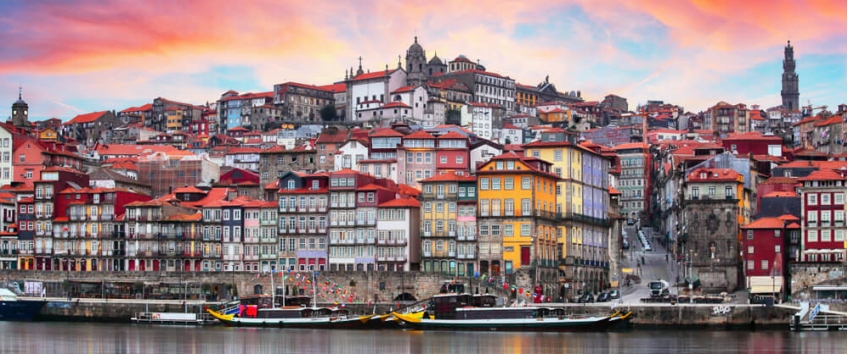To visit Porto is to dive into the past and the future. The magic of Porto lies in its ability to evolve, preserving the traces of the past that make it so special and different from other cities. Here, the famous Praça da Ribeira (Ribeira Square) is a must-visit. Take a cruise and enjoy this perfect combination: Praça da Ribeira, the Douro river and the scenic beauty of old Porto.
Porto, known as “Capital of the North”, is one of the oldest cities in Portugal and has always played a vital role in the country's history. The development and modernization of the city do not hide the traces of the past, clearly visible to those who walk the narrow streets of the historic center or observe the old monuments.
We cannot fail to highlight, in Porto, the mythical Praça da Ribeira, one of the oldest in the city. It is, perhaps, the most sought-after part of the city, due to its historical value and the attractive scenery it offers to visitors. It is a picturesque place, where the sale of typical and handcrafted products is still made to the sound of popular auctions. There are the grocery stores under the stairs, the taverns, the terraces, the tangle of alleys, the clothes to dry next to the old houses and the music and dance of the street artists. It is also the Wall of Bacalhoeiros, a high promenade along the river with a splendid view over the river and the city of Gaia, on the other bank. Old but touristy square, poor but with scrolls, it is a place full of life. This bustle has always attracted a lot of tourists, eager to meddle with the people of this neighborhood. At night, it is also a lively place, offering leisure places for all tastes: from Fado Houses, small bars and typical restaurants where you can find some traditional meals, like “Tripas à Moda do Porto” (Tripe Stew) and the “Iscas de Bacalhau” (cod fish patties) and the famous Francesinha.
The best way to contemplate all these surroundings is through a cruise in the Douro. Many cruises sailing in the fresh waters of the Douro have departure and arrival here. Be it the 6 bridges cruise, Porto-Régua-Porto or Porto-Pinhão-Porto, any program allows you to enjoy Ribeira from a completely different angle, but all of it is stunning.
Ribeira Square, the gateway to the city
In the Medieval Period, there already existed a market in Ribeira Square that sold products that came by boat from all over. As well as the corruption of merchants, sailors, and popular people, national or foreign. Just like today! Referred to in a royal charter by D. João I - dated 1389 -, located in the nerve center of the old city and right in the heart of the commercial activity developed around the river, this square was, in the past, the most important gateway to the city.
“Ribeira Negra”, meaning Black or Dark Ribeira (1987) is the name of the huge tile panel (54 meters long), by the painter Júlio Resende, which is close to the D. Luís I Bridge, and which portrays the colorful life that flows so well in this riverside square. The artist immediately realized that in this area next to the Douro River, a different way of life had developed, since forever, especially in the relationship with the land, water, and men.
Praça da Ribeira also offers us the superb spectacle of a city that rises, in cascade, from the river. The houses were being built on the bank to better receive what the boats brought: the fish, the wine, and the goods. As the poet Eugénio de Andrade says: «Toda a gente sabe que no Porto, entre a Sé e a Ribeira, as casas se empinam umas nas outras como os acrobatas no circo» this means that Everyone knows that in Porto, between Sé and Ribeira, the houses are tilted together like acrobats in the circus.
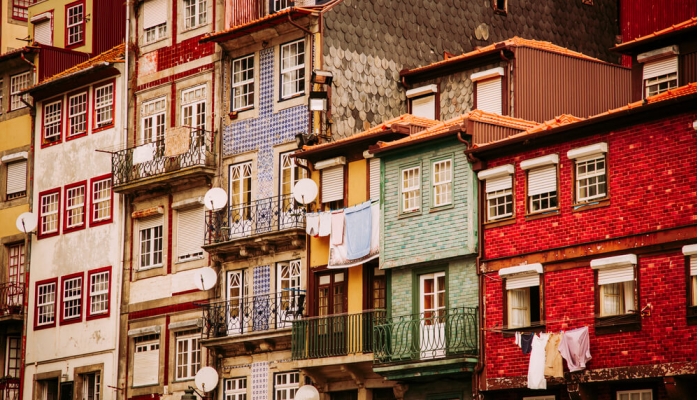 Praça da Ribeira offers the superb spectacle of a city that rises, in cascade, from the Douro River!
Praça da Ribeira offers the superb spectacle of a city that rises, in cascade, from the Douro River!Ribeira not only marked the people, but the history of the city. Through some of its constructions we can make a chronology of the main events:
Fernandina Wall and the Guindais Funicular
The Fernandina Wall is the name by which the medieval belt of walls in Porto became known, finished in the 14th century in the reign of D. Fernando, of which only small parts have survived until today.
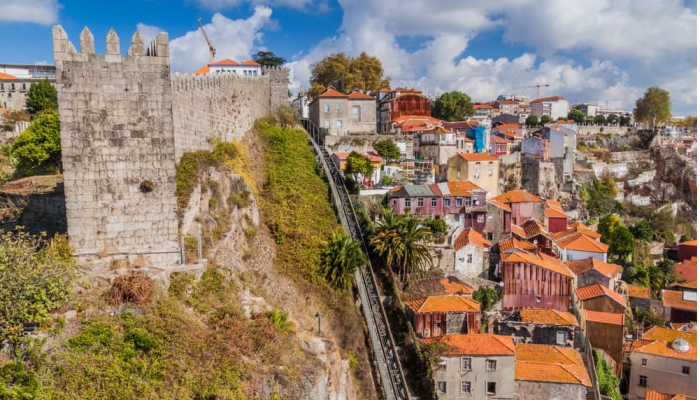 The Guindais Funicular offers an impressive view over the Fernandina Wall, the D. Luis I Bridge and the Douro River
The Guindais Funicular offers an impressive view over the Fernandina Wall, the D. Luis I Bridge and the Douro River Located next to the steep escarpment of Guindais, a Funicular was built within the scope of the works of Porto 2001, Capital of Culture, which connects the surroundings of Praça da Batalha to the lower deck of Porto D. Luis I, and which offers a superb panoramic view over the Douro river and its banks.
Luis I Bridge
The splendid Luís I bridge built in 1886 by Théofile Seyring, Gustave Eiffel's assistant, is a brilliant example of iron architecture and is one of the 6 Bridges that connect Porto and Vila Nova de Gaia.
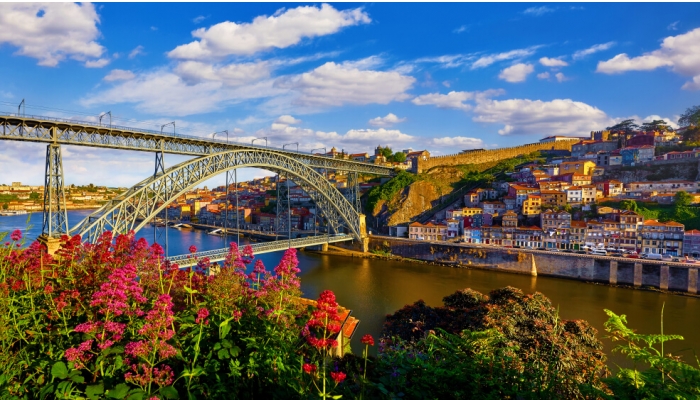 The splendid D. Luís I Bridge is a brilliant example of iron architecture.
The splendid D. Luís I Bridge is a brilliant example of iron architecture.It unites the cities through 2 trays: the lower one serves the road traffic and the upper one is crossed by Metro do Porto. One of the most important points of interest in the City of Porto, which you can visit on our tour - Porto City Tour.
Memmorial to Ponte das Barcas
The legendary Ponte das Barcas was a bridge over the Douro River that existed between the banks of Porto and Gaia, built on barges. It was sadly linked to one of the most tragic events in the city's history: the Ponte das Barcas Disaster. On March 29, 1809, thousands of French soldiers, under Soult's command, invaded Porto. In a climate of great panic and dread, many city dwellers rushed towards the bridge to escape to the other bank. Then there was the tragedy. Some reports say the bridge was purposely cut; others say the bridge fell under the weight of the fugitives. What is certain is that thousands of people drowned in the waters of the Douro on that fateful day. The tragedy was portrayed in a bronze bas-relief by the sculptor Teixeira Lopes. This memorial, made in 1897, is often nicknamed “alminhas da Ponte” (bridge souls) and was placed at the Ribeira Wall roughly where the bridge ended on the Porto side. Architect Eduardo Souto Moura also built two symmetrical sculptures on both banks, in memory of the disaster.
Suspension Bridge Pillars
The fragility of the Ponte das Barcas exacerbated by the tragic accident of 1809, and the needs imposed by the growing traffic between the riverside banks of Porto and Gaia put pressure on the construction of a new bridge.
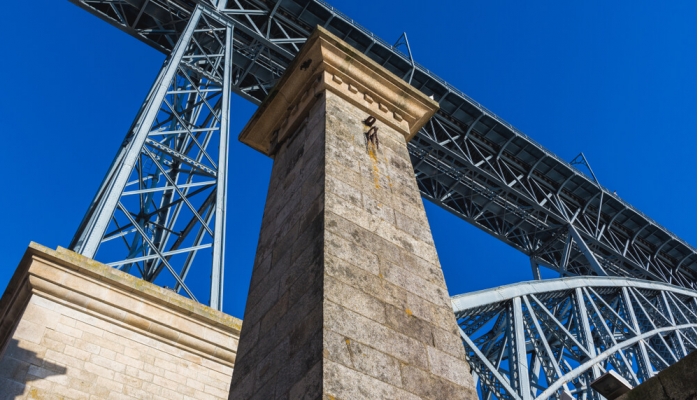 Pillars of the extinct Pênsil Bridge, next to the majestic D. Luís I Bridge
Pillars of the extinct Pênsil Bridge, next to the majestic D. Luís I BridgeThe Bridge opened to traffic in 1843, but only remained in service for 44 years, when it was replaced by the D. Luís I Bridge. Demolition work started immediately, with only 2 pillars remaining on the side of the Bridge today and the guardhouse.
The Monumental Fountain and the Cube
Praça da Ribeira, of medieval origin, was totally transformed in the 18th century by João de Almada, the great reformer of the city. The monumental fountain that was placed in the center of the square, in granite and baroque style, that bears the coat of arms of Portugal dates from that time. Later, a statue of Saint John the Baptist, by sculptor João Cutileiro, was placed in its niche. Praça da Ribeira is also known to the people of Porto as “Praça do Cubo” (Cube Square), since the “Cubo das Pombas da Paz” , by José Rodrigues, was placed there, when the remains of an old fountain were discovered there.
“Postigo do Carvão” – (Coal Wicket)
Between Ribeira Pier and Estiva Pier, we will find Postigo do Carvão, the only surviving entrance to the wall brace.
Casa do Infante, birthplace of Infante D. Henrique
According to tradition, Infante D. Henrique - the great impetus for the Portuguese Discoveries - was born in this house, dating from the 13th century, which served as Royal Customhouse, Money House and the royal family's guesthouse when staying in the city. It is currently the headquarters of the Porto´s Municipal Historical Archive.
Due to the diversity of monuments in a single square, one can understand the importance of this place, which has been part, since 1996, of the core of the historic center which is World Heritage by UNESCO. To live up to the title and welcome visitors, Praça da Ribeira opens its arms to all visitors all day and all night. Enjoy a magnificent cruise in the Douro from this square, so full of history and traditions, enjoy the fantastic view and then relax on one of its many terraces, Contact Us!

